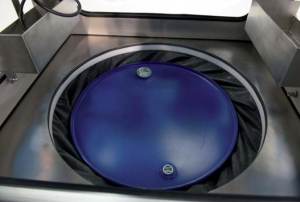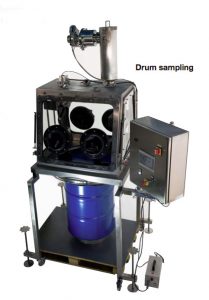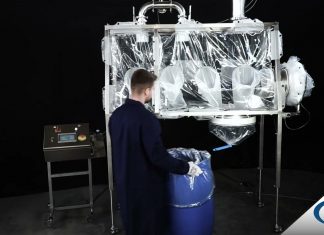An innovative new solution, created and patented by CSV Life Science,
has already obtained important results confirming its performance and safety. This activity will culminate in the creation of a new brand: CSV Containment.
Watch the video!
In 2007, a leading Italian producer of active pharmaceutical ingredients (API) asked CSV Life Science to conduct a feasibility study concerning the design and development of a containment system for the discharge points of seven drying filters in an unclean environment. The problem to be addressed was not one of safety, but rather the need to obtain a finished product in line with GMP requirements, which had to be discharged in a clean room with controlled contamination. In studying the various technologies that might be used, a solution was found based on the use of a plastic material produced by American company ILC Dover that, appropriately modified, seemed to represent a good solution to the specific problem. The proposal was to set up protections around the process area, which would allow operators to work in ergonomic conditions. Once the validity of the idea has been acknowledged by the European management of ILC Dover, a meeting was set up at the US headquarters of the company, and a collaboration was started. This was made official two years later, when CSV became the American company’s exclusive agent on the Italian and other markets. Between 2009 and now, a number of unique pharmaceutical applications have been developed using this flexible containment technology, all specially designed for use in the process area during the synthesis of API or the realization of final products. In many cases there were considerable difficulties that had to be overcome in order to develop prototypes and tackle application cases for which other technologies had failed to provide adequate solutions. Since last year, CSV Life Science has also enjoyed the collaboration of Chargepoint, a company that produces special split valves able to shut off the transfer of active ingredients and aseptic processes: this collaboration has made it possible for the company to enter the field of sterile products too. It is already a couple of years since the company started developing solutions usingmixedmaterials(steel,Hastelloy in combination with glass, valuable conductive plastics and transparent rigid plastics, including antistatic ones).



A technology developed to solve specific application cases
Faced with a specific problem, raised by a client, there emerged a need to couple drums for an anti-acid charging system, but without using consumables, in other words going beyond the conventional bag in/bag out procedure, which involves containing the path between the drum and chamber by means of a polyethylene tube that is stretched around the head of the drum (or the outer bag present in the drum itself) and coupled with the interface on the isolator chamber using orings. This operation, often laborious, involves the introduction of consumables and, especially in the case of large drums, requires the use of lifting devices and, above all, two operators. The separation is equally laborious, necessitating “manual” compression of the plastic containing the path and its separation by means of “crimping” systems; in some cases, in place of the costliercrimpingsystems, setsofdual clamps are used instead, although this results in significant losses and there- fore lower performance levels. To address the problem more effectively, it was decided to use a dual iris-type diaphragm interface, positioned as in a pass box, instead of the usual folding doors. Therefore, a cylindrical pass box was constructed, rather than the usual square or rectangular ones, which are very difficult to use with drums, especially medium sized or large ones. Initially, CSV thought that the above interface could be created using commercially available valves; however, during the course of the project, it became apparent that it required diameters and materials that are not readily available on the market, and design a mechanism able to couple the two iris diaphragms at the ends of a tube sealed with the chamber. This mechanism is now under patent application. At present, CSV is able to make diaphragms with diameters of up to a 700 mm, suitable useful for 200-litre drums, but the peculiarity of the CSV interface is that it can be used on all drums with diameters less than this. The double elastic barrier sealed to the drum, between the outside and the chamber, makes it possible to minimize the surface of the drum that comes into contact with the chamber, and possibly to automate, without introducing con- sumables, the drum charging and emptying operations. The first ATEX grade machine, valid for working in class 2/22 zone, was created to charge a dryer with anti-acid system: built in Hastelloy and conductive materials (PTFE filled with graphite and conductive EPDM), its design complies with the Machinery Directive.

Dedicated lines for various application cases
After this first experience, a product line was created that includes double coupling with steel (or Hastelloy) and glass, or with a soft or rigid plastic isolator.
Another specific production line, dedicated to GMP or Reach applications, involves the use of a single iris diaphragm interface and a number of specific solutions. This version features a telescopic and wheeled system, which varies in terms of the coupling with the charging point (a flange or hatch), while the rest of the chamber is universal: it, too, is built in steel and glass, or in flexible or rigid plastic, and it is not polarized. On the basis of these alternative solutions, the following have therefore been created: a drum coupling system, with a rigid chamber in steel/glass or other materials; the simple pass box, installed on existing charging systems, doors or isolators; the coupling to a PTS system (for pneumatic transfer) with flexible coupling to drums by means of an iris diaphragm interface; a plastic isolator, which is flexible and ergonomic in terms of the handling of the gun which, thanks to the iris diaphragm and a small pantograph, allows the coupling with the drum to be contained while avoiding the problem of consumables. A dispensing system is currently being developed with the following features: drum coupling and two-chamber lifter on the rear side in the position of the gloves, bottom drainage into a Chargepoint bottle by means of SPLIT coupling, lateral pass box with a double iris diaphragm, and drum sampling station in inert/controlled atmosphere with horizontal iris diaphragm. “To crown these experiences”, comment Luca Vietri and Andrea Pederzini of CSV Life Science, “we intend to propose a new brand, which we have called CSV Containment. The new technology will be officially unveiled at Powtech in Nuremberg next September, shown again at CPhI in Frankfurt in October and then, very likely, also at Achema next year. We are also opening up a special line of communication on social networks and through dedicated brochures. Furthermore, we will also be offering the possibility to visit our facilities. Over the past few months, some users have already had the opportunity to see the station and almost all have already put in orders for applications of interest to them. This extremely positive response con- firms that the new solution is perceived as a structural novelty, with the capacity to provide a very effective response to a major problem.”
Research & Development and facilitated financing
 With projects like this under way, CSV has started to plan a budget for its Research & Development activity and to tackle issues such as facilitated financing and grant funding. It has now started budgeting of its research activity, which is documented by contracts with external bodies (universities, laboratories or suppliers) and patents (four have been filed to cover this type of application).
With projects like this under way, CSV has started to plan a budget for its Research & Development activity and to tackle issues such as facilitated financing and grant funding. It has now started budgeting of its research activity, which is documented by contracts with external bodies (universities, laboratories or suppliers) and patents (four have been filed to cover this type of application).
The company has also applied for funding under the European Horizon 2020 programme that, designed to promote Research & Development and Innovation, rewards organizations that produce globally profitable solutions that can improve the efficiency, productivity and competitiveness of European companies.
Furthermore, CSV has already obtained a certificate of excellence from the European Union, attesting to the high level of the proposed solution. The same type of approach will likely be adopted for future research projects too.

































